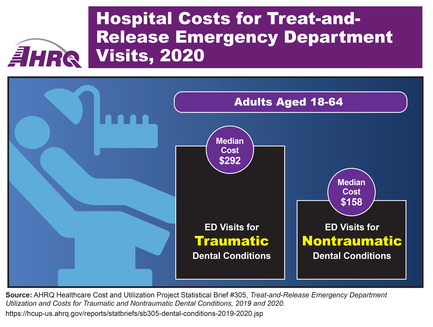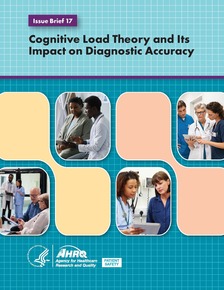May 21, 2024, Issue #914 Editor’s note: Due to the Memorial Day holiday, AHRQ News Now will not publish next week. AHRQ Stats
Access more data on this topic in the associated statistical brief, plus additional AHRQ data infographics.
Today's Headlines:  AHRQ’s essential role in advancing healthcare is the subject of a new blog post by agency Director Robert Otto Valdez, Ph.D., M.H.S.A. The blog—the second in a series celebrating AHRQ’s 35th anniversary—emphasizes the need to redouble efforts to improve healthcare not only in 2024 but also in the decades ahead. While the National Institutes of Health lead the way globally in biomedical research, AHRQ plays a leading role in technology assessment, which examines how new technologies can be introduced to improve current care delivery, and health services research, which supports progress by examining the organization, delivery and financing of today’s healthcare. AHRQ will continue to lead efforts to advance medical progress along these pathways, making today’s research tomorrow’s healthcare. To receive all blog posts, submit your email address. AHRQ’s essential role in advancing healthcare is the subject of a new blog post by agency Director Robert Otto Valdez, Ph.D., M.H.S.A. The blog—the second in a series celebrating AHRQ’s 35th anniversary—emphasizes the need to redouble efforts to improve healthcare not only in 2024 but also in the decades ahead. While the National Institutes of Health lead the way globally in biomedical research, AHRQ plays a leading role in technology assessment, which examines how new technologies can be introduced to improve current care delivery, and health services research, which supports progress by examining the organization, delivery and financing of today’s healthcare. AHRQ will continue to lead efforts to advance medical progress along these pathways, making today’s research tomorrow’s healthcare. To receive all blog posts, submit your email address. |
 Hospice providers serving more assisted-living patients tended to receive lower-quality ratings than those caring for fewer patients, according to an AHRQ-funded study in the Journal of the American Geriatrics Society. Researchers based their findings on AHRQ’s Consumer Assessment of Healthcare Provider and Systems (CAHPS) Hospice Survey, which assesses the experiences of hospice patients who subsequently die and their caregivers. They found that among high-volume assisted-living hospice providers, quality was lower across several domains including pain assessment, dyspnea treatment, emotional support, team communications and family care training. Access the abstract. Hospice providers serving more assisted-living patients tended to receive lower-quality ratings than those caring for fewer patients, according to an AHRQ-funded study in the Journal of the American Geriatrics Society. Researchers based their findings on AHRQ’s Consumer Assessment of Healthcare Provider and Systems (CAHPS) Hospice Survey, which assesses the experiences of hospice patients who subsequently die and their caregivers. They found that among high-volume assisted-living hospice providers, quality was lower across several domains including pain assessment, dyspnea treatment, emotional support, team communications and family care training. Access the abstract. |
 As part of AHRQ’s ongoing efforts to advance patient safety, the agency has published two new evidence reviews to help healthcare leaders prioritize and implement safety strategies: As part of AHRQ’s ongoing efforts to advance patient safety, the agency has published two new evidence reviews to help healthcare leaders prioritize and implement safety strategies:
The reviews are part of the agency’s Making Healthcare Safer IV report, a continuous updating of evidence on safety harms and practices. First published in 2001, Making Healthcare Safer reports have consolidated information sources for healthcare providers, health system administrators, researchers and government agencies. The reports align with the agency’s lead role in advancing safety, including establishment of the National Action Alliance for Patient and Workforce Safety, a growing public-private collaboration to improve safety across healthcare delivery settings. |
AHRQ’s Patient Safety Network (PSNet) highlights journal articles, books and tools related to patient safety. Articles featured this week include:
Review additional new publications in PSNet’s current issue, including recent cases and commentaries and AHRQ’s WebM&M (Morbidity and Mortality Rounds on the Web).  Measuring consumer spending on primary care is essential to improving healthcare delivery and outcomes, but an accurate picture of current spending is unknown because of variations in the ways that states conduct estimates, according to an AHRQ-funded research letter in JAMA Health Forum. For example, while nine states calculate primary care spending as a percentage of total healthcare spending, 10 others estimate spending by payor type. Lack of standardization and transparent measurements across states weakens what could be a powerful tool to monitor primary care investments, the authors concluded. They asserted that a standard primary care spending definition could lead to deeper understanding and help connect spending policy changes to health outcomes. Access the letter, which was based on an AHRQ technical brief. Measuring consumer spending on primary care is essential to improving healthcare delivery and outcomes, but an accurate picture of current spending is unknown because of variations in the ways that states conduct estimates, according to an AHRQ-funded research letter in JAMA Health Forum. For example, while nine states calculate primary care spending as a percentage of total healthcare spending, 10 others estimate spending by payor type. Lack of standardization and transparent measurements across states weakens what could be a powerful tool to monitor primary care investments, the authors concluded. They asserted that a standard primary care spending definition could lead to deeper understanding and help connect spending policy changes to health outcomes. Access the letter, which was based on an AHRQ technical brief. |
 A new AHRQ issue brief provides an overview of fundamental cognitive load theory concepts. It dives into what is and is not yet known about the interplay between cognitive load theory and diagnostic accuracy, while providing a review of ways to measure and understand its causal impact on diagnostic accuracy. The brief concludes with recommendations for future research and improvement efforts. Access the brief and other AHRQ publications on diagnostic safety topics. A new AHRQ issue brief provides an overview of fundamental cognitive load theory concepts. It dives into what is and is not yet known about the interplay between cognitive load theory and diagnostic accuracy, while providing a review of ways to measure and understand its causal impact on diagnostic accuracy. The brief concludes with recommendations for future research and improvement efforts. Access the brief and other AHRQ publications on diagnostic safety topics. |
The safety culture of hospital providers and staff is fundamentally linked to patient safety culture, according to an AHRQ study published in BMC Health Services Research. Researchers reviewed nearly 6,700 responses to AHRQ’s Surveys on Patient Safety Culture® (SOPS®) Hospital Survey 2.0 and the SOPS Hospital Workplace Safety Supplemental Item Set. The largest number of associations between survey measures were overall support from hospital leaders; being able to report workplace safety problems without negative consequences; and overall rating on workplace safety. The study underscores the essential role of fostering robust safety cultures in healthcare to enhance safety and well-being for both staff and patients, researchers concluded. | AHRQ in the Professional LiteratureDevelopment and evaluation of patient safety interventions: perspectives of operational safety leaders and patient safety organizations. Gomes KM, Handley J, Pruitt ZM, et al. J Patient Saf. 2024 May 13. [Epub ahead of print.] Access the abstract on PubMed®.
Leveraging human-centered design and causal pathway diagramming toward enhanced specification and development of innovative implementation strategies: a case example of an outreach tool to address racial inequities in breast cancer screening. Marcotte LM, Langevin R, Hempstead BR, et al. Implement Sci Commun. 2024 Mar 28;5(1):31. Access the abstract on PubMed®. Cultural brokering in pregnancy care: a critical review. DiMeo A, Karlage A, Schoenherr K, et al. Int J Gynaecol Obstet. 2023 Nov;163(2):357-66. Epub 2023 Sep 8. Access the abstract on PubMed®.
Characterizing changes to older adults' care transition patterns from hospital to home care in the initial year of COVID-19. Arbaje AI, Hsu YJ, Zhou Z, et al. J Am Geriatr Soc. 2024 Apr;72(4):1079-87. Epub 2024 Mar 5. Access the abstract on PubMed®.
Utilization of electronic health record sex and gender demographic fields: a metadata and mixed methods analysis. Foer D, Rubins DM, Nguyen V, et al. J Am Med Inform Assoc. 2024 Apr 3;31(4):910-8. Access the abstract on PubMed®.
Race-ethnicity and sex differences in 1-year survival following percutaneous coronary intervention among Medicare fee-for-service beneficiaries. Savitz ST, Falk K, Stearns SC, et al. J Eval Clin Pract. 2024 Apr;30(3):406-17. Epub 2023 Dec 13. Access the abstract on PubMed®.
Association between Medicare's sepsis reporting policy (SEP-1) and the documentation of a sepsis diagnosis in the clinical record. Barbash IJ, Davis BS, Saul M, et al. Med Care. 2024 Jun;62(6):388-95. Epub 2024 Apr 12. Access the abstract on PubMed®.
Evaluating airway management in patients with trisomy 21 in the PICU and cardiac ICU: a retrospective cohort study. Wilsterman EJ, Jr., Nellis ME, Panisello J, et al. Pediatr Crit Care Med. 2024 Apr;25(4):335-43. Epub 2023 Dec 7. Access the abstract on PubMed®. Contact Information
For comments or questions about AHRQ News Now, contact Bruce Seeman, (301) 427-1998 or Bruce.Seeman@ahrq.hhs.gov. |